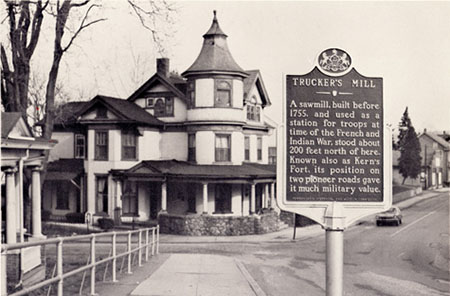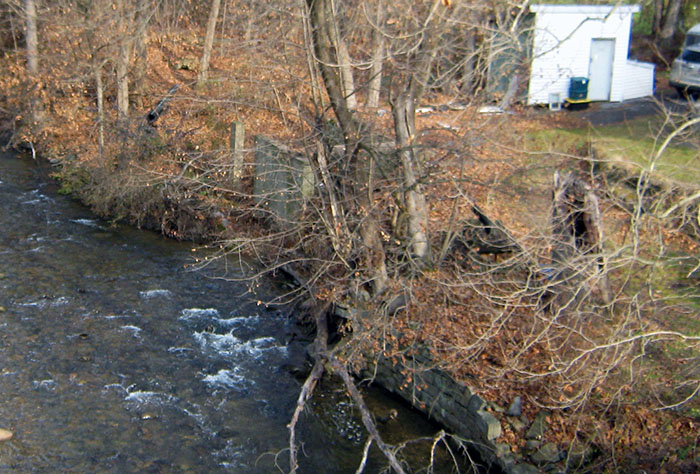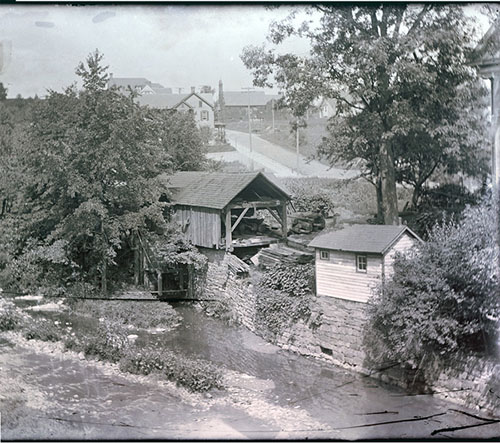Kern’s saw mill (aka Trucker’s mill) was located about 100 ft. north of the Slatington Main Street bridge over Trout Creek. It was powered with water from Kern’s dam, about 400 ft. further north up the creek, via a mill race. The mill was about 15 ft. x 35 ft. with a later addition of a wood shed. At first a vertical, “up and down” saw was used, and that was later replaced with a circular saw.
The saw mill was tied directly to the fortunes of the Kern family.
Nicholas (Nicolaus) Kern (1693-1749) arrived in Philadelphia in 1727 and took up land in the Lehigh County area, which was then part of Bucks County. By the late 1730s, he had acquired about seven hundred acres in the area of present-day Slatington, and by the early 1740s he had built a house, a saw mill and a grist mill. Nicholas operated both mills until his death in 1749.
After Nicholas’ death, the will provided that his wife Maria Margaretha would manage the estate until the youngest child, Lorentz, came of age. When that happened, 1/3 of the estate went to Maria Margaretha and the remainder was divided between 8 children (Henry, Frederick, Cornelia, William, Nicholas, John, George and Lorentz). Around 1770, the wife and children agreed to release to John a tract of 226 acres and to William a tract of 140 acres since both John and William intended to remain in the Slatington area.
As a side note, in 1762, Nicholas Jr. (1727-1803) married Eva Elizabeth Bowman (1729-1798). She was the widow of Hans Dieter Bowman (1707-1761) who had arrived in Philadelphia in 1727 on the same ship as Nicholas Kern, and he had settled in the Lehigh Gap area and a bit northwards to the Bowmanstown area.
Ulrich “William” Kern (1725-1800) was the son of Nicholas Kern. He took over the saw mill, and it was in 1756 that Benjamin Franklin commissioned lumber from the Kern saw mill for the construction of Fort Allen at Weissport, PA, about eight miles north along the Lehigh River. Since this was during the French and Indian Wars, a small detachment of militia was stationed at Kern’s mill to provide security from Indian raids.

Postcard view of the old Kern's mill historical marker on the Main Street bridge
On his death, Ulrich “William” Kern deeded land to his sons: George (1772-1850), Nicholas (1773-1849) and Johannes “John” (1777-1851). The latter, “John,” succeeded his father at the mill. John was the grandson of the original Nicholas.
At some point in time, the mill was moved to a location on Factory Street in lower Slatington.
Jonas Kern (1805-1892), the second son of John Kern and the great-grandson of the first Nicholas Kern, took over both the saw mill and the grist mill. The saw mill was relocated to its site north of the Main Street bridge, and the grist mill was rebuilt.
At the death of Jonas in 1861, his estate transferred the mills to his daughter Violetta (1832-1863), the wife of Henry Kuntz (1830-1905). Kuntz rented the mills out to various parties over the ensuing years.
Alfred J. Kern (1847-1933), who was the son of Johan Carl “Charles” Kern (1805-1860) and the grandson of Christopher Kern (1768-1841) and the great-grandson of Ulrich William Kern, successfully operated the mills as a rental from 1872 until 1877 when he purchased the land and mills.
In August 1931, Alfred sold the saw and grist mills and about 15 acres of land around Kern's dam to his son, Howard Elias Kern (1875- 1971). Howard was married to Annie S. Kern (1885-1972). He operated the grist mill until retiring in 1948. Supposedly the grist mill was operated in the 1950s by Ambrose "Laffy" Serfass (1908-1985), a retired postman. It appears that the saw mill had ceased operation in the 1930s. In 1946, the circular saw and accompaying saw carriage were removed from the saw mill by the Husack brothers of Slatington R2. That was not the original saw, which was an "up and down" saw.
The end of Kern’s saw mill was tied to the fate of Kern’s grist mill.
In June 1975, Howard Kern turned over 12.7 acres including the two mills and the land in the immediate vicinity of the mills to Lehigh County for 1$ as a proposed historical site. Instead, what resulted was years of confusion and hand-wringing over what to do with both mills and the overall site.
There were plans to clean up the site, put in nature trails, restore the mills, repair the dam, and create a park. There were always questions about funding for any repair, restoration or revitalization.
In just a year, finger-pointing had begun between the county and the town. When the borough asked the county about $75,000 that had been part of a bond issue in 1975 for the park, the county replied that it had to check on that money. But the county commissioner in charge of parks noted that it “would be a waste of taxpayers’ money” to do anything with the site and that “it would be cheaper to raze the old building and construct a likeness on the same site.” Plus, the commissioner considered the mill a traffic hazard. The Morning Call headline (10 August 1976) was clear about the county’s intent, “Commissioners Opposing Slatington Mill Restoration.” The commissioners indicated that the site should still be developed as a park, or Lehigh County could give Slatington $75,000 “to use at the park as it sees fit.”
Nothing seemed to happen.
In August 1981, the county offered to lease the park to the borough for $1, stating that the county never had any plans to improve the park, but county did have funds available for the demolition of the mill. The borough declined the offer.
Then, in December 1981, the county began dismantling Kern’s mill in preparation for its eventual destruction. It was interesting that a restriction in the transfer deed called for the mill to remain standing and possibly be turned into the museum, but the county lawyers “found a clause” that said the mill could be destroyed as long as the site remained as open space and was used for recreation.
I am not sure exactly when the saw mill was dismantled, but it would have been at roughly the same time that the grist mill was destroyed.
In June 1999, Lehigh County transferred ownership of the park to the borough.
When I was still living in Slatington decades ago, the remanants of the saw mill (the stone wall and a shack) were still there, but over the years, bit-by-bit, things disappeared.

The site of Kern's saw mill in Slatington, 2023
